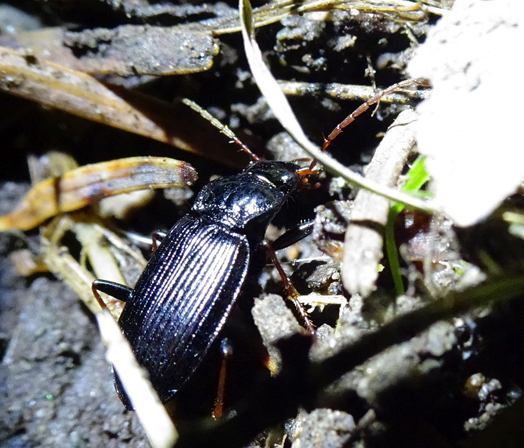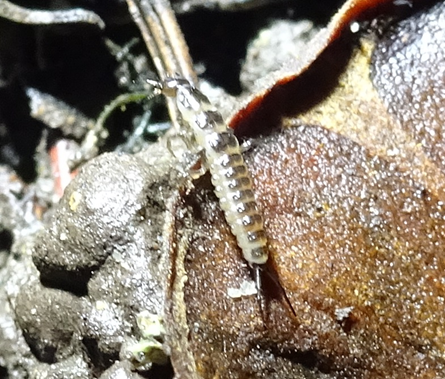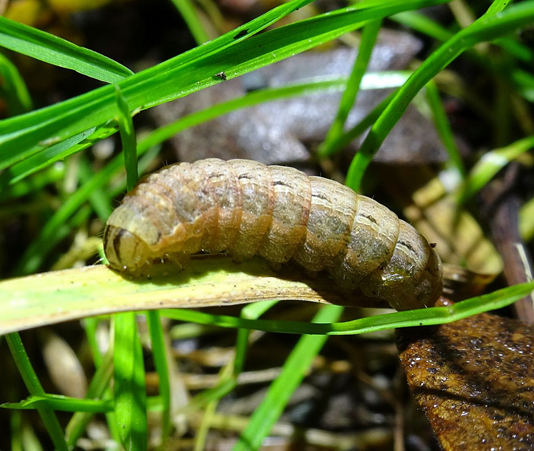November 9 morning
2020 November 9 morning
Apologies to viewers for a gap in service in the last few days. This was the result of a computer glitch, which is now fixed.
More miscellaneous creatures from the ground detritus at Colquitz River Park, by Ian Cooper:


Nebria brevicollis (Col.: Carabidae) Ian Cooper
Jeremy Tatum writes: What in the world is the animal below? It appears to be (but isn’t! See below!) a two-pronged bristletail (Diplura). In modern classifications it is a hexapod but not an insect. The divisions of the Hexapoda have undergone some revisions in recent years, and some animals that were formerly included in the Class Insecta are no longer considered to be insects. My present understanding is as follows:
Within the Phylum Arthropoda is included the Subphylum Hexapoda. Within the Subphylum Hexapoda are several Classes, which include Insecta, Arachnida, Entognatha. Each of these Classes are divided into several or (in the case of Insecta) many Orders.
The Class Arachnida includes spiders, mites, ticks, harvestmen, scorpions.
The situation with regard to springtails and bristletails is now a little complicated, and not all authors agree.
Springtails used to belong to the insect Order Collembola.
The springtails are no longer insects, but they belong to Class Entognatha, within which are four Orders of different groups of springtails, namely Entomobryomorpha, Symphypleona,
Poduromorpha, Neelipleona.
There used to be three sorts of bristletails, belonging to the insect Orders Thysanura (three-pronged bristletails), Diplura (two-pronged bristletails) and Microcoryphia (jumping bristletails).
There are now, as before three sorts of bristletails: three-pronged bristletails, two-pronged bristletails, and jumping bristletails, but their classification is a little different that formerly. These used to be respectively the Orders Thysanura, Diplura and Microcoryphia within the Class Insecta. The Order names Thysanura and Microcoryphia are no longer supposed to be used, but are replaced by the Order names Zygentoma and Archaeognatha. Whether the Orders Zygentoma and Archaeognatha remain in the Class Insecta or are in the Class Entognagtha varies with author. The Order Zygentoma (formerly Thysanura) includes the Family Lepismatidae (firebrats and silverfish). The Order Archaeognatha (formerly Microcoryphia) are the jumping bristletails. The Diplura are not at all closely related to the other bristletails. Some authors place them as an Order within the Class Entognatha. Others promote them to Class (i.e. of the same rank as Insecta, Arachnidae, Entognagtha).
Now, after that lengthy learned article about bristletails, it appears that the animal isn’t one after all (though I’ll leave the learned article up in case we do ever get a genuine one). Charlene Wood believes it is a beetle larva, and it is therefore, an insect! Possibly Carabidae or Staphylinidae – she’d need to see a close-up of the tarsal claws to go further! Further photographs of this animal by Ian Cooper, showing the head more clearly, are posted on November 15.


Beetle larva (possibly Carabidae or Staphylinidae) Ian Cooper


Large Yellow Underwing Moth Noctua pronuba (Lep.: Noctuidae)
Maybe more this afternoon…
